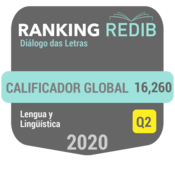Primary school teachers' purposes and beliefs about the use of L1 in the EFL classroom
DOI:
https://doi.org/10.22297/2316-17952021v10e02124Palavras-chave:
Primary Education. Second language instruction. Teacher role.Resumo
This research study analyses the purposes of the use of Spanish as first language (L1) in the English as Foreign Language (EFL) classroom in a primary school in Cadiz (Andalusia), Spain. The work involves a descriptive mixed-methods analysis in which data were collected mainly through systematic observation of EFL classes (N = 15) and teacher interviews (N = 2) during the academic year 2019-20. The results reveal (i) a high amount of L1 use by both teacher and learners; (ii) a remarkable number of interventions in L1; and (iii) an unmeaningful purpose of L1 use, among others. Final recommendations are provided on ways of using L1 in EFL teaching in primary education (6-12 years).
Downloads
Referências
ANTON, M.; DICAMILLA, F. Socio-cognitive functions of L1 collaborative interaction in the L2 classroom. Canadian modern language review, v. 54, n. 3, p. 314-342, 1998.
ATKINSON, D. The mother tongue in the classroom: a neglected resource? ELT journal, v. 41, n. 4, p. 241-247, 1997.
CABALLOS, M. Del bilingüismo al plurilingüismo. Una política educativa de incentivación de las L2 en la Comunidad andaluza. Teoría y realidad". In: BRUÑA, M.; CABALLOS, M.; ILLANES, I.; RAMíREZ GÓMEZ, C.; RAVENTÓS, A. (org.). La cultura del otro: español en Francia, francés en España. Seville: University of Seville. 2006. p. 1005-1019.
BLYTH, C. Redefining the boundaries of language use: the foreign language classroom as a multilingual speech community". In: Kramsch, C. (org.). Redefining the boundaries of language study. Boston: Heinle & Heinle, 1995. p. 145-183.
BOOKS-LEWIS, K. Adult learners"™ perceptions of the incorporation of their L1 in foreign language teaching and learning. Applied linguistics, v. 30, n. 2, p. 216-235, 2009.
BUTZKAMM, W. Code-switching in a bilingual history lesson: The mother tongue as a conversational lubricant. International journal of bilingual education and bilingualism, v. 1, p. 81-99, 1998.
BUTZKAMM, W. We only learn language once. The role of the mother tongue in FL classrooms: death of a dogma. Language learning journal, v. 28, n. 1, p. 29-39, 2003.
COOK, V. Using the first language in the classroom. Canadian modern language review, v. 57, n. 3, p. 402-423, 2001.
COOK, G. Translation in language teaching: an argument for reassessment. Oxford: Oxford University Press, 2010.
COPLAND, F.; NEOKLEOUS, G. L1 to teach L2: complexities and contradictions. ELT journal, v. 65, n. 3, p. 270-280, 2011.
CRAWFORD, J. Language choices in the foreign language classroom: target language or the learners' first language? RELC journal, v. 35, n. 1, p. 5-20, 2004.
DE LA CAMPA, J. C.; NASSAJI, H. The amount, purpose, and reasons for using L1 in L2 classrooms. Foreign language annals, v. 42, n. 4, p. 742-759, 2009.
DUFF, P.; POLIO, C. How much foreign language is there in the foreign language classroom? The modern language journal, v. 74, n. 2, p. 154-166, 1990.
GAJÅ T, N. Students"™ attitudes towards the use of Slovene as L1 in teaching and learning of business English at tertiary level. ELOPE: English Language Overseas Perspectives and Enquiries, v. 14, n. 1, p. 95-112. 2017.
GENESEE, F. Integrating language and content: lessons from immersion. Educational practice reports, 11. National center for research on cultural diversity and second language learning. Washington: Center for Applied Linguistics, 1994.
HALL, G.; COOK, G. Own language use in ELT: Exploring global practices and attitudes. Language issues: The ESOL journal, v. 25, n. 1, p. 35-43, 2014.
HARBORD, J. The use of mother tongue in the classroom. ELT journal, v. 46, n. 4, p. 350-355, 1992.
HE, A. Systematic use of mother tongue as learning/teaching resources in target language instruction. Multilingual education, v. 2, n. 1, p. 1-15, 2012.
HIGAREDA, S.; LOPEZ, G.; MUGFORD, G. ¿Duermes mucho Tony? Interpersonal and transactional uses of L1 in the foreign-language classroom. Profile issues in teachers"™ professional development, v. 11, n. 2, p. 43-54, 2009.
JIMOLA, F.; OFODU, G. ESL teachers and diagnostic assessment: Perceptions and practices. ELOPE: English Language Overseas Perspectives and Enquiries, v. 16, n. 2, p. 33-48, 2019.
KANEKO, T. The role of the first language in foreign language classrooms. Unpublished doctoral dissertation. Temple University: Philadelphia, 1992.
KIM, S.; ELDER, C. Language choices and pedagogic functions in the foreign language classroom: a cross-linguistic functional analysis of teacher talk. Language teaching research, v. 9, n. 4, p. 355-380, 2005.
KRASHEN, S. Principles and practice in second language acquisition. Englewood Cliffs: Prentice-Hall International, 1982.
KRASHEN, S.; TERREL, T. The natural approach: language acquisition in the classroom. London: Prentice Hall Europe, 1983.
LARSEN-FREEMAN, D. A complexity theory approach to second language development/acquisition. In: A., D. (org.). Alternative approaches to second language acquisition. Abingdon: Routledge, 2011. p. 48-72.
LASAGABASTER, D. The use of the L1 in CLIL classes: The teachers"™ perspective. Latin American journal of Content & Language Integrated Learning, v. 6, n. 2, p. 1-21, 2013.
LEVINE, G. Student and instructor beliefs and attitudes about target language use, first language use, and anxiety: Report of a questionnaire study. The modern language journal, v. 87, n. 3, p. 343-364, 2003.
LITTLEWOOD, W.; YU, B. First language and target language in the foreign language classroom. Language teaching, v. 44, n. 1, p. 64-77, 2011.
LIU, D.; AHN, G. S.; BAEK, K. S.; HAN, N. O. South Korean high school English teachers' code switching: Questions and challenges in the drive for maximal use of English in teaching. Tesol Quarterly, v. 38, n. 4, 605-638, 2004.
MACARO, E. Issues in target language teaching. In: FIELD, K. (org.). Issues in modern foreign languages teaching. Abingdon: Routledge, 2000. p. 171-189.
MACARO, E., TIAN, L.; CHU, L. First and second language use in English medium instruction contexts. Language teaching research, v. 24, n. 3, p. 382-402, 2018.
MACMILLAN, B.; TURNBULL, M. Teachers' use of the L1 in French immersion: revisiting a core principle. In: TURNBULL, M.; DAILEY-O'CAIN, J. (org.). First language use in second and foreign language learning: Intersection of theory, practice, curriculum and policy. Bristol: Multilingual Matters. p. 15-34 2009.
MORA, I., LENGELING, M., RUBIO, B., CRAWFORD, T.; GOODWIN, D. Students and teachers' reasons for using the first language within the foreign language classroom (French and English) in Central Mexico. Profile issues in teachers professional development, v. 13, n. 2, p. 113-129, 2011.
PIASECKA. K. Using mother tongue in teaching adult immigrants. Language issues the journal of NATES LA, v. 1, n. 1, p. 29-30, 1986.
POLIO, C.; DUFF, P. Teachers' language use in university foreign language classrooms: A qualitative analysis of English and target language alternation. Modern language journal, v. 78, p. 313-26, 1994.
PRODOMOU, L. The role of the mother tongue in the classroom. IATEFL (April-May), p. 6-8, 2002.
RODRíGUEZ JUíREZ, C.; OXBROW, J. L1 in the EFL classroom: more a help than a hindrance? Porta linguarum, n. 9, p. 93-109, 2008.
ROMANOWSKI, P. A comparative study of CLIL trajectories in the Polish education system. ELOPE: English Language Overseas Perspectives and Enquiries, v. 16, n. 2, p. 63-76, 2019.
SCHEWEERS, W. Using L1 in the L2 classroom. English teaching forum online, v. 37, n. 2, p. 6-13, 1999.
SEÅ EK, U. "˜Teacher English"™: Teacher"™s target language use as cornerstone of successful language teaching. ELOPE: English Language Overseas Perspectives and Enquiries, v. 2, n. 1-2, p. 223-230, 2005.
VILLAMIL, O.; DE GUERRERO, M. Peer revision in the L2 classroom: social cognitive activities, mediating strategies, and aspects of social behaviour. Journal of second language writing, v. 5, n. 1, p. 51-75, 1996.
WACH, A.; MONROY, F. Beliefs about L1 use in teaching English: a comparative study of Polish and Spanish teacher-trainees. Language teaching research, v. 24, n. 6, p. 855-873, 2019.
XHEMAIL, M. The advantages and disadvantages of mother tongue in teaching and learning English for specific purposes (ESP) classes. Anglisticum: Journal of the Association-Institute for English Language and American Studies, v. 2, n. 3, p. 191-195. 2016.
YENICE, E. The use of L1 in EFL classrooms in the context of Turkey. Turkey: UludaÄŸ University, Bursa, 2018.
YOUNG, D. An investigation of students"™ perspectives on anxiety and speaking. Foreign language annals, v. 23, n. 6, p. 539-553, 1990.
ŽELJEŽIČ, M. Debate in EFL Classroom. ELOPE: English Language Overseas Perspectives and Enquiries, v. 4, n. 1, p. 39-54, 2017.
Downloads
Publicado
Como Citar
Edição
Seção
Licença
Copyright (c) 2021 Diálogo das Letras

Este trabalho está licenciado sob uma licença Creative Commons Attribution 4.0 International License.
A Diálogo das Letras não se responsabiliza por conceitos e opiniões emitidos pelos autores, tampouco manifesta, necessariamente, concordância com posições assumidas nos textos publicados. Além disso, os dados e a exatidão das referências citadas no trabalho são de inteira responsabilidade do(s) autor(es). Ao submeterem seus trabalhos, os autores concordam que os direitos autorais referentes a cada texto estão sendo cedidos para a revista Diálogo das Letras; ainda concordam que assumem as responsabilidades legais relativas às informações emitidas.


















